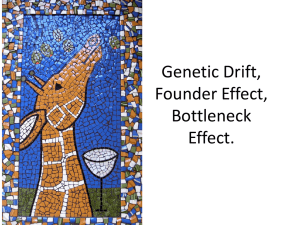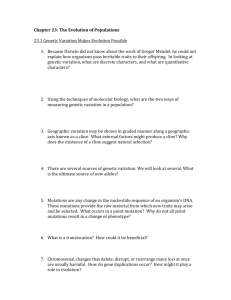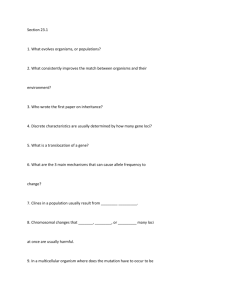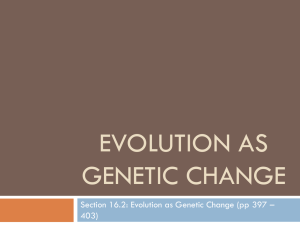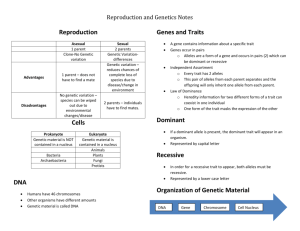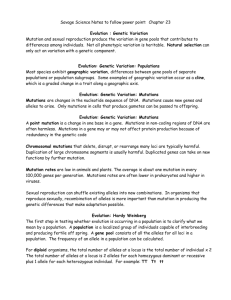Chapter 23.1 Questions 1. Define microevolution. 2. What are the
advertisement
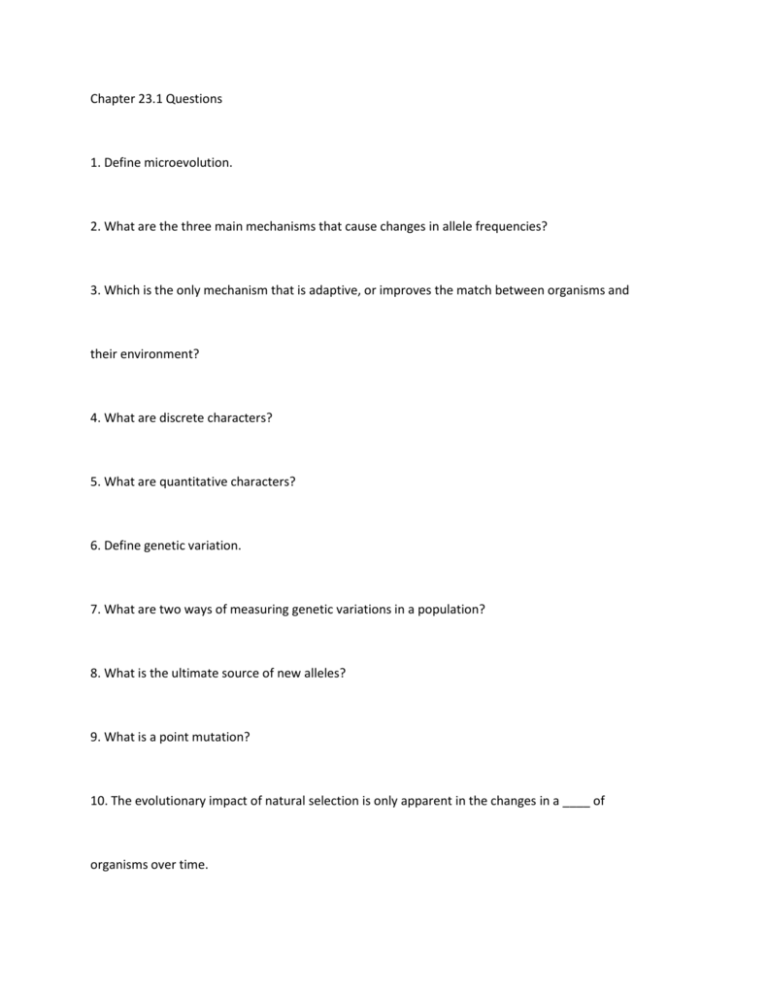
Chapter 23.1 Questions 1. Define microevolution. 2. What are the three main mechanisms that cause changes in allele frequencies? 3. Which is the only mechanism that is adaptive, or improves the match between organisms and their environment? 4. What are discrete characters? 5. What are quantitative characters? 6. Define genetic variation. 7. What are two ways of measuring genetic variations in a population? 8. What is the ultimate source of new alleles? 9. What is a point mutation? 10. The evolutionary impact of natural selection is only apparent in the changes in a ____ of organisms over time. 11. What is average heterozygosity? 12. What is geographic variation? Chapter 23.2 Questions 1. What is the Hardy-Weinberg Principle? 2. What are 3 of the 5 conditions of the Hardy-Weinberg Equilibrium? 3. What is a cline? 4. Gene variability can be quantified as what? 5. What does it mean for an allele to be fixed? 6. What is a gene pool? 2= ? 7. P 2= ? 8. q 9. We can characterize a population’s genetic makeup by describing its _____. 10. What is a group of individuals of the same species that live in the same area and interbreed, producing fertile offspring called? 11. Who created the Hardy-Weinberg principle? 12. Does “p” represent a dominant or recessive allele? Chapter 23.3 Questions 1. Is genetic drift more significant in small or large populations? 2. What is genetic drift? 3. Define the founder effect. 4. Describe the bottleneck effect. 5. What is gene flow? 6. Genetic drift causes what to change at random? 7. T/F – Genetic drift can lead to an increase in generic variation within populations. 8. What effect does generic drift have on harmful alleles? 9. In what sense is natural selection more “predictable” than genetic drift? 10. What is adaptive evolution? 11. Name two examples of events that could cause a bottleneck effect. 12. What is an example of how allele frequencies can be altered? 13. Give two examples of circumstances that can result in genetic drift having a significant impact on a population. Chapter 23.4 Questions 1. What consistently increases the frequencies of alleles that enhance survival and reproduction? 2. If individuals who are heterozygous at a particular locus have a greater advantage than do both kinds of homozygous, they exhibit what? 3. What is the fitness of a phenotype that depends on how common it is in the population called? 4. What occurs when natural selection maintains two or more forms in a population? 5. What is the form of selection in which individuals of one sex are choosy in selecting their mates from the other sex? 6. What is relative fitness? 7. In how many ways can natural selection alter the frequency distribution of heritable traits? 8. What are the three modes of natural selection? 9. Regardless of the mode of selection the basic mechanism does what? 10. What kind of individuals does selection favor? 11. Natural selection alters the frequency distribution of what? 12. In diploid eukaryotes, a considerable amount of genetic variation is hidden in the form of what kind of alleles? 13. Evolution is limited by what kind of constraints? 14. Selection can act only on what? Chapter 23.1 Answer Key 1. Change in allele frequencies in a population over generations 2. Natural selection, genetic drift, and gene flow 3. Natural Selection 4. Can be classified on an either-or basis, determined by a single gene locus with different alleles that produce distinct phenotypes 5. Variance long a continuum within a population, results from the influence of 2 or more genes on a single phenotypic character 6. Differences among individuals in the composition of their genes or other DNA segments. 7. Whole gene level (gene variability) --- Molecular level of DNA (Nucleotide variability) 8. Mutations 9. Change in a single nucleotide pair of a gene 10. Population 11. The average percentage of loci that are heterozygous 12. Differences in the genetic composition of separate populations Chapter 23.2 Answer Key 1. Frequencies of alleles and genotypes in a population that remain constant from generation to generation. 2. No mutations, Random mating, no natural selection, extremely large population size, and no gene flow 3. A graded change in a character along a geographic axis 4. Average heterozygosity 5. If only one allele exists for a particular locus in a population and all individuals are homozygous for that allele 6. A gene pool consists of all copies of every type of allele at every locus in all member s of the population 7. Homozygous dominant 8. Homozygous recessive 9. Gene pool 10. Population 11. Hardy and Weinberg 12. Dominant Chapter 23.3 Answer Key 1. Small 2. Chance events that cause allele frequencies to fluctuate unpredictably from one generation to the next 3. Small groups separate from a large population to form their own population. 4. Genetic drift that occurs when the size of a population is reduced due to a natural disaster or human actions 5. The transfer of alleles into or out of a population 6. Allele frequencies 7. False 8. It has the potential to fix the alleles 9. In natural selection, individuals that have certain inherited traits tend to survive and reproduce at higher rates than other individuals because of those traits 10. Evolution that results in a better match between organisms and their environment 11. Fire, flood, deforestation, etc. 12. New mutations 13. The founder and bottleneck effects Chapter 22.4 Answer key 1. Natural selection 2. Heterozygous advantage 3. Frequency-dependent selection 4. Balancing selection 5. Intersexual selection 6. The contribution an individual makes to the gene pool of the next generation relative to the contributions of other individuals 7. Three 8. Directional selection, disruptive selection, and stabilizing selection 9. Remains the same 10. Those who have heritable, phenotypic traits with higher reproductive success than the traits of others 11. Heritable traits 12. Recessive 13. Historical 14. Existing variations
